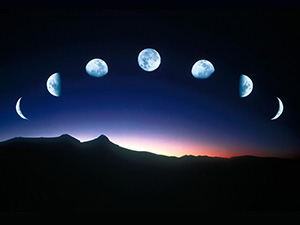Unearthing the Moon's Many Myths and Mysteries
Nature's Brightest Light Leaves Questions to be Answered
by Jaleah Price, age 14

A
little over four and a half billion years ago, a solid mass called
the Moon was formed. The Moon has given rise to many myths, legends,
and mysteries. Some, for example, believe that it influences our
lives and destinies. Others once thought that the Moon may even be a
god or goddess.
One
mystery surrounding the Moon is how it was formed. Two distinct
theories exist. The first, "The Collison Theory," suggests
that the Moon was created when a large object struck the Earth,
breaking off a large piece of it. Collecting space debris around it,
this chunk of Earth formed an orbiting cloud and solidified as a
mass.
Others
support "The Capture Theory." This theory indicates that
the Moon was always a separate mass from the Earth. When passing by
the Earth closely, it was caught and pulled in by the Earth's
gravitational pull. However, calculations points more so in favor of
The Collison Theory.
A
bleak place with no atmosphere, the Moon has
an extreme environment. Surface
temperatures on the Moon can change
drastically. During
the daytime,
temperatures can reach 260 degrees Fahrenheit, while at night they
can fall to a low of
negative 279 degrees Fahrenheit. Dark
regions called maria, craters, and mountainous areas cover the
Moon's surface. Life
on the Moon would be very unlikely because of this
harsh environment.
The
Moon glows because it reflects
light from the Sun. Every 27.3 days, the Moon orbits the Earth: how
much of the Moon we can see depends on what stage of the orbit it is
in. Depending
on how the light shines on one particular part of the Moon, the shape
that we see from Earth appears
as a crescent moon
(waxing), a half
moon (first quarter), a
full moon (appears
round), a half
moon (last quarter),
or a crescent moon
(waning). The Moon continues to have the same side facing Earth while
it completes each
orbit.
Sometimes
during its orbit, the Moon passes directly between the Earth and Sun.
When this happens, a solar eclipse occurs. The Earth becomes dark
for a few moments as the Moon blots out the Sun’s bright light.
Though
researches have discovered a significant amount of information about
the Moon, there remains many questions to be answered.
[Source:
The Kingfisher Children’s
Encyclopedia
]
|

